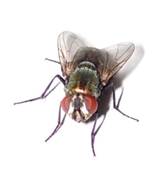Insects and Other Bugs

Next to microbiological organisms, insects are probably the most commonly encountered pest within the home or workplace. Insects found indoors are often more of a nuisance than a human health hazard but there are some indoor insects that can adversely impact your health. Cockroaches, for example, can spread food borne pathogens. Severe infestations can also set off asthmatic reactions. Fleas can serve as vectors of disease (plague). Additionally, insects such as termites or carpenter ants cause physical damage to structures which results in costly repairs. Outdoors, insects can not only damage structures but also desirable plants or serve as vectors of disease. Stinging insects may illicit severe allergic reactions when they sting susceptible individuals. If you need help further identifying a specific insect you can contact your local cooperative extension office or perform your own search on using the Insect Identification tools found on Virginia Tech’s Insect Identification Lab website.
Virginia Tech has also developed various Pest Management Guides which provide information about various control options. The Home Grounds and Animal guide, a resource of the Virginia Cooperative Extension (VCE), includes chapters with information about managing insects which are commonly found around the home, lawn or garden.
- Insects in Home Vegetables (Chapter 2)
- Insects of Home Fruit (Chapter 3, Home Fruit: Diseases and Insects)
- Home Ornamentals (Chapter 4)
-Insects of Trees, Shrubs, Annuals, and Perennials (Page 4-27)
-Organic Controls for Insects of Home Ornamentals (Page 4-73)
-Insects in Foliage and Houseplants (Page 4-74)
- Lawn (Chapter 5, Lawn Diseases (includes Lawn Insects on Page 5-3)
- Nuisance Insects of the House and Yard (Chapter 6)
-Insects in Recreation Areas, Page 6-1
-Wood-Destroying Insects, Page 6-5
-Household Insects, Page 6-7 - Pets: Dog and Cat External Parasites (Chapter 7, Covers fleas and ticks)
Insect Pests of Ornamental Plants Slide Show
Other Pest Specific Resources |
||
Stinging and Biting Pests (UGA Extension) |
||
Fleas (UC IPM) |
Stored Food Pests (NC State) |
|
Bedbugs (VDACS, VCE, VPI & SU) |
Fly (Blow Fly) |
|
Fly (Cluster Fly) |
Spiders (UC IPM) |
|
Carpenter Bees (PennState) |
German Cockroach (PennState) |
Spider (Brown Recluse) |
Mosquitoes (EPA) |
Spider (Widow Spider) |
|
| Cave (Camel) Crickets (Clemson) | Old House Borers (PennState) | Spider (Wolf Spider) |
| Centipedes & Millipedes (UNL) | Powderpost Beetles (Oregon SU) | Termite Signs and Treatment |
Hiring a professional? Check their qualifications
Individuals or businesses that apply pesticide commercially to control plant diseases must be licensed by the Office of Pesticide Services. In addition, their employees must be certified.To learn more visit the following sections of the website:
Is Your Pest Control Company Licensed?
Hiring a Professional